Nursing Assignment: Community Care for Elderly Patients
VerifiedAdded on 2022/08/15
|12
|3076
|15
Report
AI Summary
This report critically analyzes the literature on community care for elderly individuals with multiple chronic diseases, focusing on supporting independent living at home. The assignment examines the rationale for community care, highlighting its benefits for patients with conditions like diabetes, hypertension, and arthritis. It explores the crucial role of nurses in care management, including education, emotional support, and therapeutic interventions. The report addresses the challenges of home-based care, such as household hazards and medication errors, and emphasizes the need for thorough risk assessments. It also discusses the importance of care management processes, including referrals, legal and ethical considerations, and the involvement of family members. The conclusion emphasizes the need for an integrated approach that considers medical needs, patient preferences, and systematic strategies to maximize independence and improve the quality of life for elderly patients in the community.
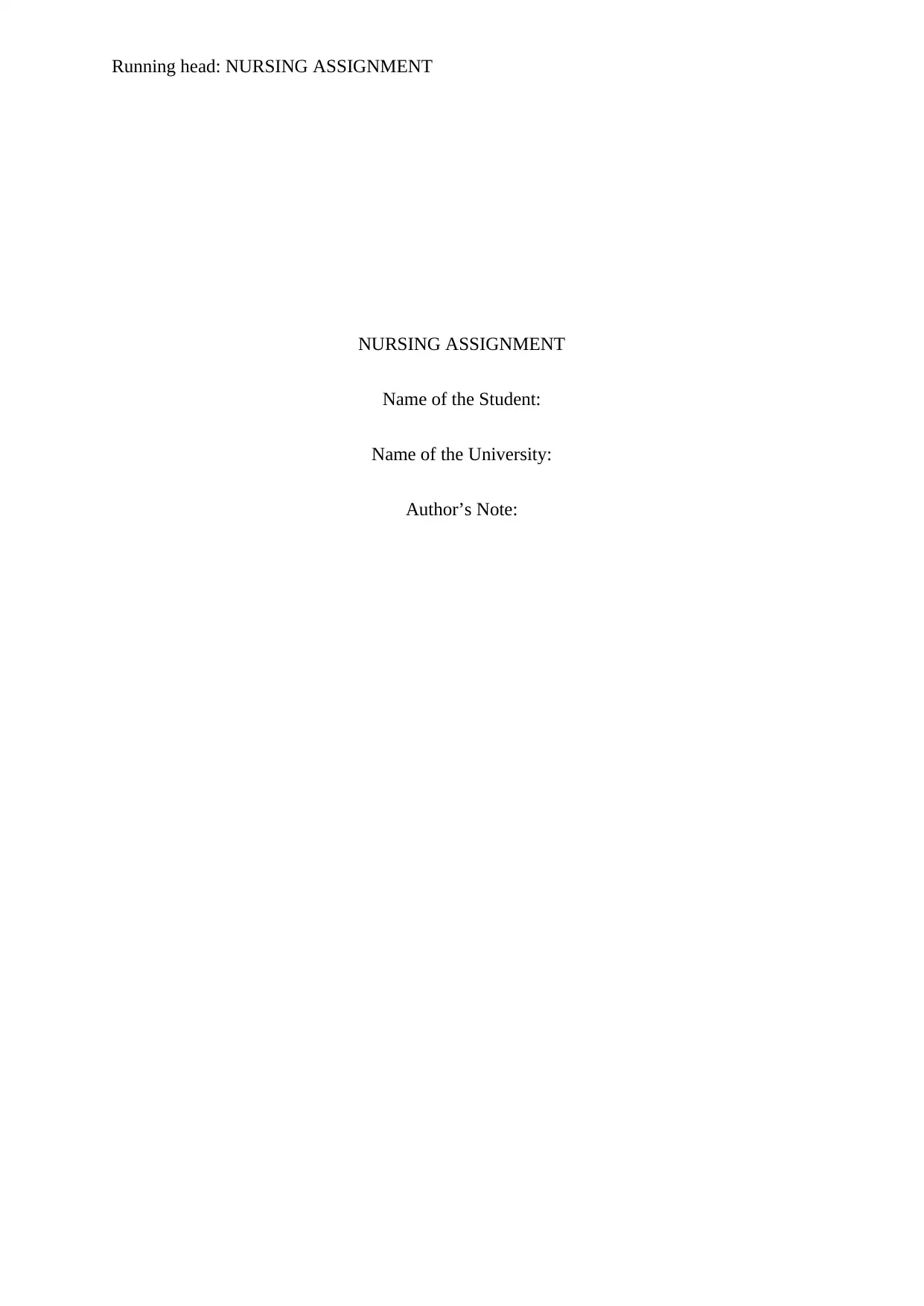
Running head: NURSING ASSIGNMENT
NURSING ASSIGNMENT
Name of the Student:
Name of the University:
Author’s Note:
NURSING ASSIGNMENT
Name of the Student:
Name of the University:
Author’s Note:
Paraphrase This Document
Need a fresh take? Get an instant paraphrase of this document with our AI Paraphraser
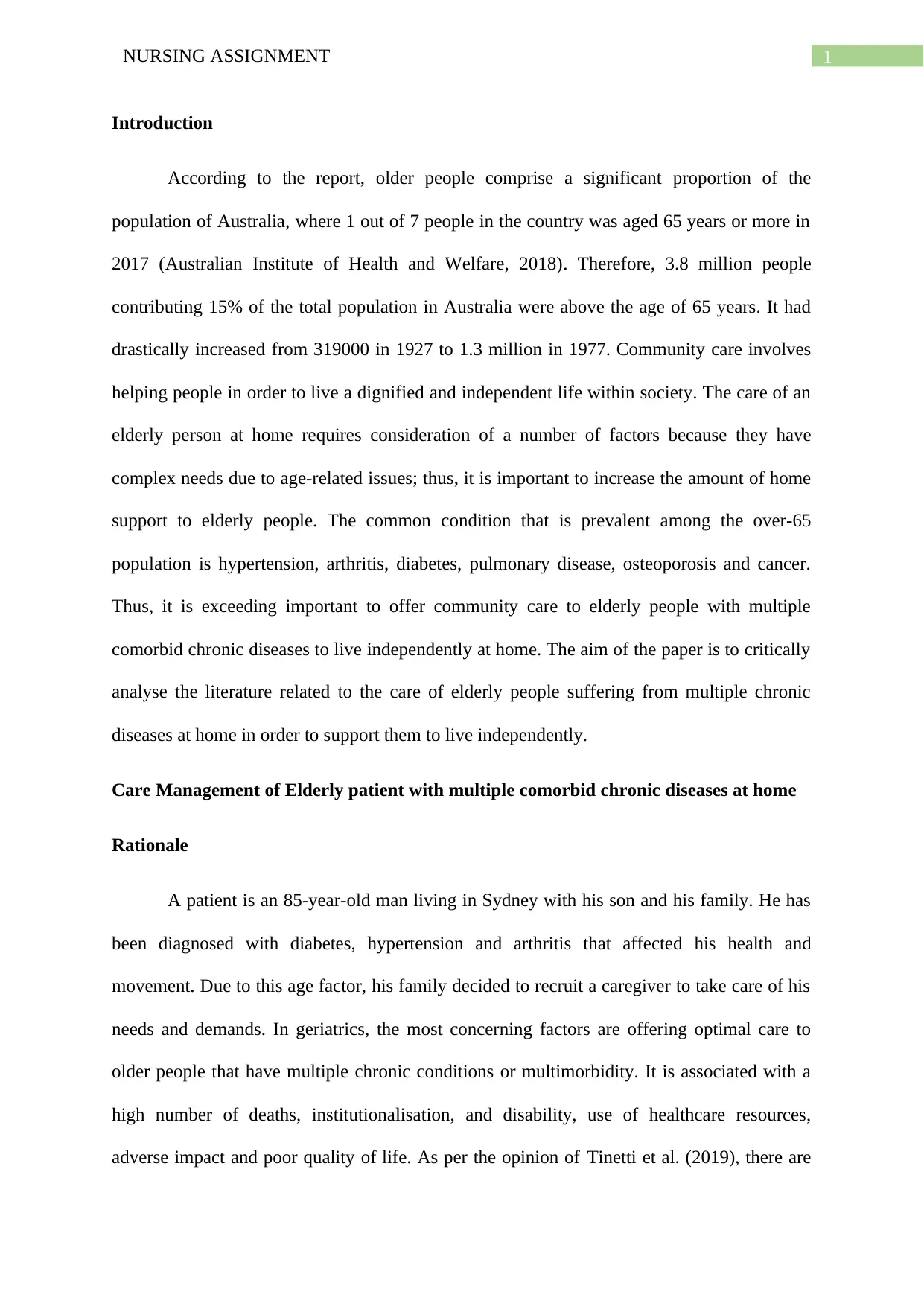
1NURSING ASSIGNMENT
Introduction
According to the report, older people comprise a significant proportion of the
population of Australia, where 1 out of 7 people in the country was aged 65 years or more in
2017 (Australian Institute of Health and Welfare, 2018). Therefore, 3.8 million people
contributing 15% of the total population in Australia were above the age of 65 years. It had
drastically increased from 319000 in 1927 to 1.3 million in 1977. Community care involves
helping people in order to live a dignified and independent life within society. The care of an
elderly person at home requires consideration of a number of factors because they have
complex needs due to age-related issues; thus, it is important to increase the amount of home
support to elderly people. The common condition that is prevalent among the over-65
population is hypertension, arthritis, diabetes, pulmonary disease, osteoporosis and cancer.
Thus, it is exceeding important to offer community care to elderly people with multiple
comorbid chronic diseases to live independently at home. The aim of the paper is to critically
analyse the literature related to the care of elderly people suffering from multiple chronic
diseases at home in order to support them to live independently.
Care Management of Elderly patient with multiple comorbid chronic diseases at home
Rationale
A patient is an 85-year-old man living in Sydney with his son and his family. He has
been diagnosed with diabetes, hypertension and arthritis that affected his health and
movement. Due to this age factor, his family decided to recruit a caregiver to take care of his
needs and demands. In geriatrics, the most concerning factors are offering optimal care to
older people that have multiple chronic conditions or multimorbidity. It is associated with a
high number of deaths, institutionalisation, and disability, use of healthcare resources,
adverse impact and poor quality of life. As per the opinion of Tinetti et al. (2019), there are
Introduction
According to the report, older people comprise a significant proportion of the
population of Australia, where 1 out of 7 people in the country was aged 65 years or more in
2017 (Australian Institute of Health and Welfare, 2018). Therefore, 3.8 million people
contributing 15% of the total population in Australia were above the age of 65 years. It had
drastically increased from 319000 in 1927 to 1.3 million in 1977. Community care involves
helping people in order to live a dignified and independent life within society. The care of an
elderly person at home requires consideration of a number of factors because they have
complex needs due to age-related issues; thus, it is important to increase the amount of home
support to elderly people. The common condition that is prevalent among the over-65
population is hypertension, arthritis, diabetes, pulmonary disease, osteoporosis and cancer.
Thus, it is exceeding important to offer community care to elderly people with multiple
comorbid chronic diseases to live independently at home. The aim of the paper is to critically
analyse the literature related to the care of elderly people suffering from multiple chronic
diseases at home in order to support them to live independently.
Care Management of Elderly patient with multiple comorbid chronic diseases at home
Rationale
A patient is an 85-year-old man living in Sydney with his son and his family. He has
been diagnosed with diabetes, hypertension and arthritis that affected his health and
movement. Due to this age factor, his family decided to recruit a caregiver to take care of his
needs and demands. In geriatrics, the most concerning factors are offering optimal care to
older people that have multiple chronic conditions or multimorbidity. It is associated with a
high number of deaths, institutionalisation, and disability, use of healthcare resources,
adverse impact and poor quality of life. As per the opinion of Tinetti et al. (2019), there are
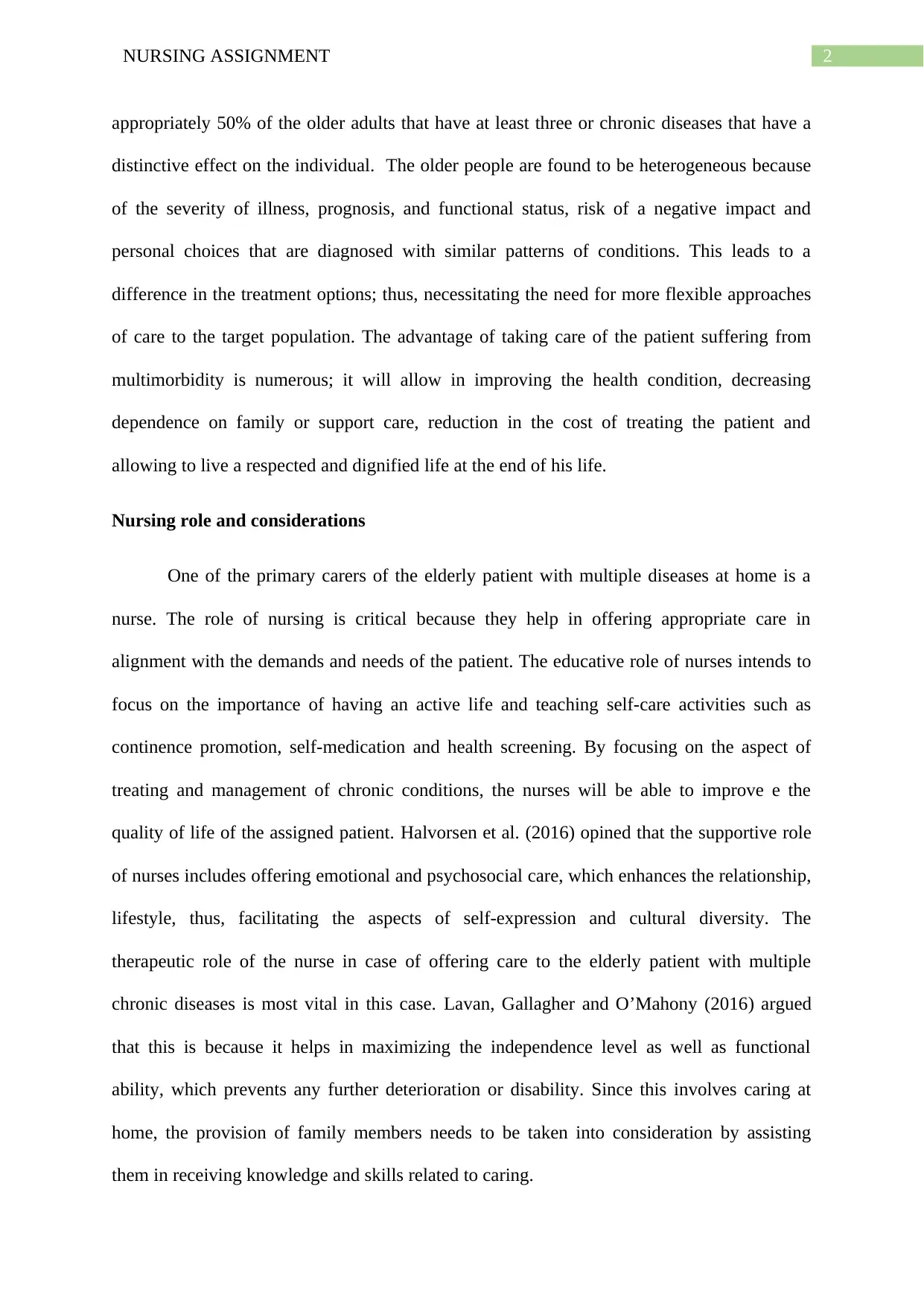
2NURSING ASSIGNMENT
appropriately 50% of the older adults that have at least three or chronic diseases that have a
distinctive effect on the individual. The older people are found to be heterogeneous because
of the severity of illness, prognosis, and functional status, risk of a negative impact and
personal choices that are diagnosed with similar patterns of conditions. This leads to a
difference in the treatment options; thus, necessitating the need for more flexible approaches
of care to the target population. The advantage of taking care of the patient suffering from
multimorbidity is numerous; it will allow in improving the health condition, decreasing
dependence on family or support care, reduction in the cost of treating the patient and
allowing to live a respected and dignified life at the end of his life.
Nursing role and considerations
One of the primary carers of the elderly patient with multiple diseases at home is a
nurse. The role of nursing is critical because they help in offering appropriate care in
alignment with the demands and needs of the patient. The educative role of nurses intends to
focus on the importance of having an active life and teaching self-care activities such as
continence promotion, self-medication and health screening. By focusing on the aspect of
treating and management of chronic conditions, the nurses will be able to improve e the
quality of life of the assigned patient. Halvorsen et al. (2016) opined that the supportive role
of nurses includes offering emotional and psychosocial care, which enhances the relationship,
lifestyle, thus, facilitating the aspects of self-expression and cultural diversity. The
therapeutic role of the nurse in case of offering care to the elderly patient with multiple
chronic diseases is most vital in this case. Lavan, Gallagher and O’Mahony (2016) argued
that this is because it helps in maximizing the independence level as well as functional
ability, which prevents any further deterioration or disability. Since this involves caring at
home, the provision of family members needs to be taken into consideration by assisting
them in receiving knowledge and skills related to caring.
appropriately 50% of the older adults that have at least three or chronic diseases that have a
distinctive effect on the individual. The older people are found to be heterogeneous because
of the severity of illness, prognosis, and functional status, risk of a negative impact and
personal choices that are diagnosed with similar patterns of conditions. This leads to a
difference in the treatment options; thus, necessitating the need for more flexible approaches
of care to the target population. The advantage of taking care of the patient suffering from
multimorbidity is numerous; it will allow in improving the health condition, decreasing
dependence on family or support care, reduction in the cost of treating the patient and
allowing to live a respected and dignified life at the end of his life.
Nursing role and considerations
One of the primary carers of the elderly patient with multiple diseases at home is a
nurse. The role of nursing is critical because they help in offering appropriate care in
alignment with the demands and needs of the patient. The educative role of nurses intends to
focus on the importance of having an active life and teaching self-care activities such as
continence promotion, self-medication and health screening. By focusing on the aspect of
treating and management of chronic conditions, the nurses will be able to improve e the
quality of life of the assigned patient. Halvorsen et al. (2016) opined that the supportive role
of nurses includes offering emotional and psychosocial care, which enhances the relationship,
lifestyle, thus, facilitating the aspects of self-expression and cultural diversity. The
therapeutic role of the nurse in case of offering care to the elderly patient with multiple
chronic diseases is most vital in this case. Lavan, Gallagher and O’Mahony (2016) argued
that this is because it helps in maximizing the independence level as well as functional
ability, which prevents any further deterioration or disability. Since this involves caring at
home, the provision of family members needs to be taken into consideration by assisting
them in receiving knowledge and skills related to caring.
⊘ This is a preview!⊘
Do you want full access?
Subscribe today to unlock all pages.

Trusted by 1+ million students worldwide
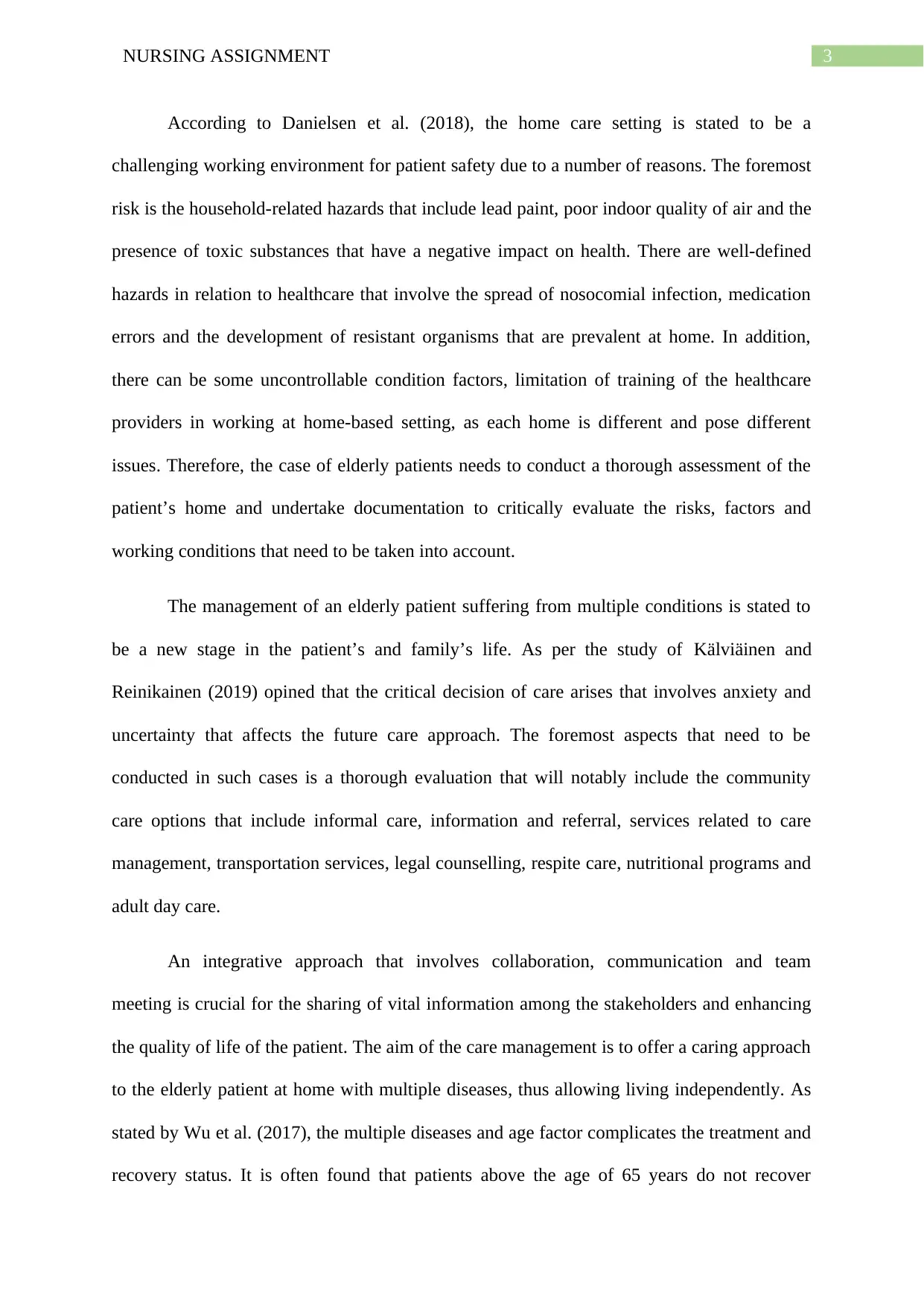
3NURSING ASSIGNMENT
According to Danielsen et al. (2018), the home care setting is stated to be a
challenging working environment for patient safety due to a number of reasons. The foremost
risk is the household-related hazards that include lead paint, poor indoor quality of air and the
presence of toxic substances that have a negative impact on health. There are well-defined
hazards in relation to healthcare that involve the spread of nosocomial infection, medication
errors and the development of resistant organisms that are prevalent at home. In addition,
there can be some uncontrollable condition factors, limitation of training of the healthcare
providers in working at home-based setting, as each home is different and pose different
issues. Therefore, the case of elderly patients needs to conduct a thorough assessment of the
patient’s home and undertake documentation to critically evaluate the risks, factors and
working conditions that need to be taken into account.
The management of an elderly patient suffering from multiple conditions is stated to
be a new stage in the patient’s and family’s life. As per the study of Kälviäinen and
Reinikainen (2019) opined that the critical decision of care arises that involves anxiety and
uncertainty that affects the future care approach. The foremost aspects that need to be
conducted in such cases is a thorough evaluation that will notably include the community
care options that include informal care, information and referral, services related to care
management, transportation services, legal counselling, respite care, nutritional programs and
adult day care.
An integrative approach that involves collaboration, communication and team
meeting is crucial for the sharing of vital information among the stakeholders and enhancing
the quality of life of the patient. The aim of the care management is to offer a caring approach
to the elderly patient at home with multiple diseases, thus allowing living independently. As
stated by Wu et al. (2017), the multiple diseases and age factor complicates the treatment and
recovery status. It is often found that patients above the age of 65 years do not recover
According to Danielsen et al. (2018), the home care setting is stated to be a
challenging working environment for patient safety due to a number of reasons. The foremost
risk is the household-related hazards that include lead paint, poor indoor quality of air and the
presence of toxic substances that have a negative impact on health. There are well-defined
hazards in relation to healthcare that involve the spread of nosocomial infection, medication
errors and the development of resistant organisms that are prevalent at home. In addition,
there can be some uncontrollable condition factors, limitation of training of the healthcare
providers in working at home-based setting, as each home is different and pose different
issues. Therefore, the case of elderly patients needs to conduct a thorough assessment of the
patient’s home and undertake documentation to critically evaluate the risks, factors and
working conditions that need to be taken into account.
The management of an elderly patient suffering from multiple conditions is stated to
be a new stage in the patient’s and family’s life. As per the study of Kälviäinen and
Reinikainen (2019) opined that the critical decision of care arises that involves anxiety and
uncertainty that affects the future care approach. The foremost aspects that need to be
conducted in such cases is a thorough evaluation that will notably include the community
care options that include informal care, information and referral, services related to care
management, transportation services, legal counselling, respite care, nutritional programs and
adult day care.
An integrative approach that involves collaboration, communication and team
meeting is crucial for the sharing of vital information among the stakeholders and enhancing
the quality of life of the patient. The aim of the care management is to offer a caring approach
to the elderly patient at home with multiple diseases, thus allowing living independently. As
stated by Wu et al. (2017), the multiple diseases and age factor complicates the treatment and
recovery status. It is often found that patients above the age of 65 years do not recover
Paraphrase This Document
Need a fresh take? Get an instant paraphrase of this document with our AI Paraphraser
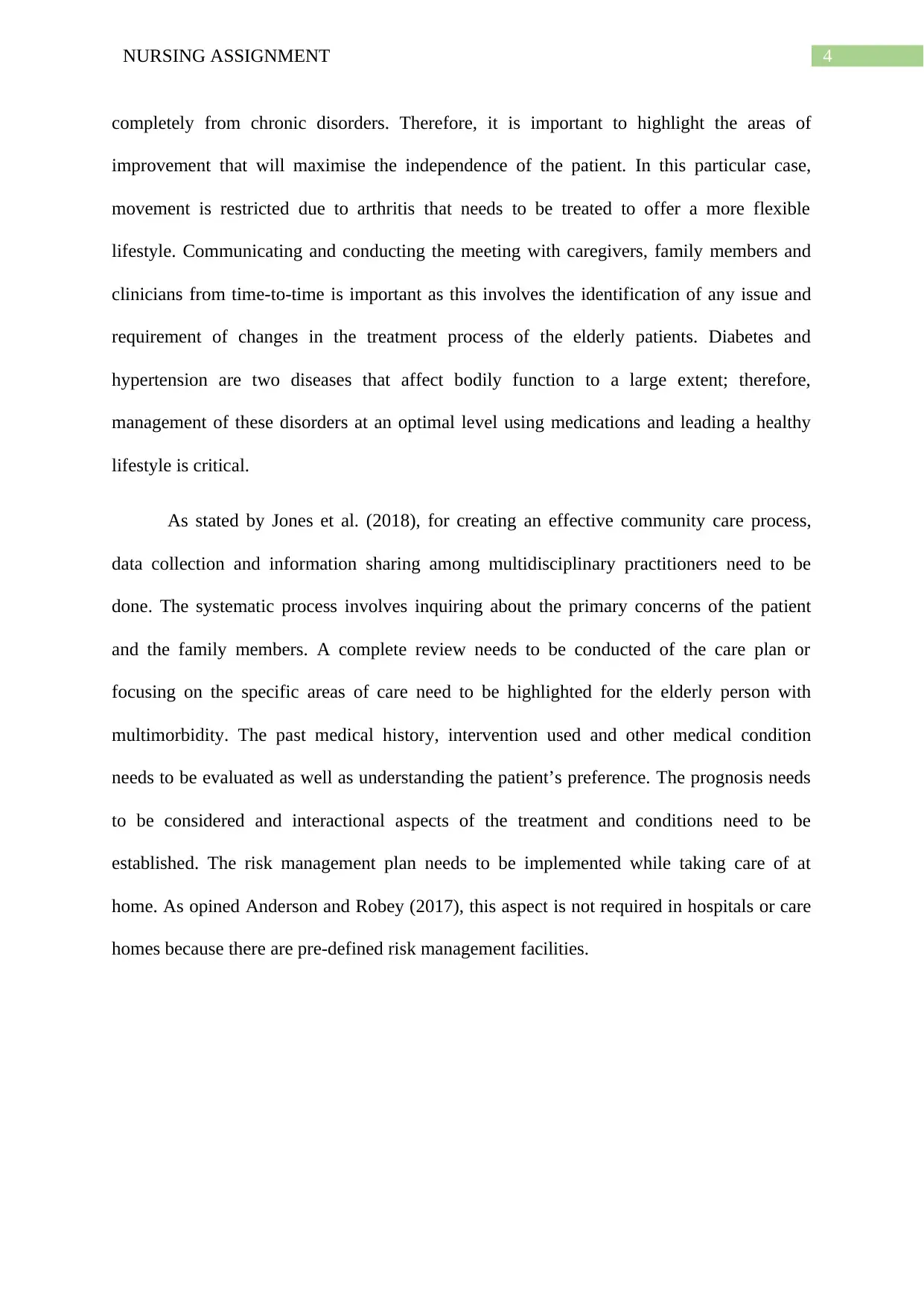
4NURSING ASSIGNMENT
completely from chronic disorders. Therefore, it is important to highlight the areas of
improvement that will maximise the independence of the patient. In this particular case,
movement is restricted due to arthritis that needs to be treated to offer a more flexible
lifestyle. Communicating and conducting the meeting with caregivers, family members and
clinicians from time-to-time is important as this involves the identification of any issue and
requirement of changes in the treatment process of the elderly patients. Diabetes and
hypertension are two diseases that affect bodily function to a large extent; therefore,
management of these disorders at an optimal level using medications and leading a healthy
lifestyle is critical.
As stated by Jones et al. (2018), for creating an effective community care process,
data collection and information sharing among multidisciplinary practitioners need to be
done. The systematic process involves inquiring about the primary concerns of the patient
and the family members. A complete review needs to be conducted of the care plan or
focusing on the specific areas of care need to be highlighted for the elderly person with
multimorbidity. The past medical history, intervention used and other medical condition
needs to be evaluated as well as understanding the patient’s preference. The prognosis needs
to be considered and interactional aspects of the treatment and conditions need to be
established. The risk management plan needs to be implemented while taking care of at
home. As opined Anderson and Robey (2017), this aspect is not required in hospitals or care
homes because there are pre-defined risk management facilities.
completely from chronic disorders. Therefore, it is important to highlight the areas of
improvement that will maximise the independence of the patient. In this particular case,
movement is restricted due to arthritis that needs to be treated to offer a more flexible
lifestyle. Communicating and conducting the meeting with caregivers, family members and
clinicians from time-to-time is important as this involves the identification of any issue and
requirement of changes in the treatment process of the elderly patients. Diabetes and
hypertension are two diseases that affect bodily function to a large extent; therefore,
management of these disorders at an optimal level using medications and leading a healthy
lifestyle is critical.
As stated by Jones et al. (2018), for creating an effective community care process,
data collection and information sharing among multidisciplinary practitioners need to be
done. The systematic process involves inquiring about the primary concerns of the patient
and the family members. A complete review needs to be conducted of the care plan or
focusing on the specific areas of care need to be highlighted for the elderly person with
multimorbidity. The past medical history, intervention used and other medical condition
needs to be evaluated as well as understanding the patient’s preference. The prognosis needs
to be considered and interactional aspects of the treatment and conditions need to be
established. The risk management plan needs to be implemented while taking care of at
home. As opined Anderson and Robey (2017), this aspect is not required in hospitals or care
homes because there are pre-defined risk management facilities.
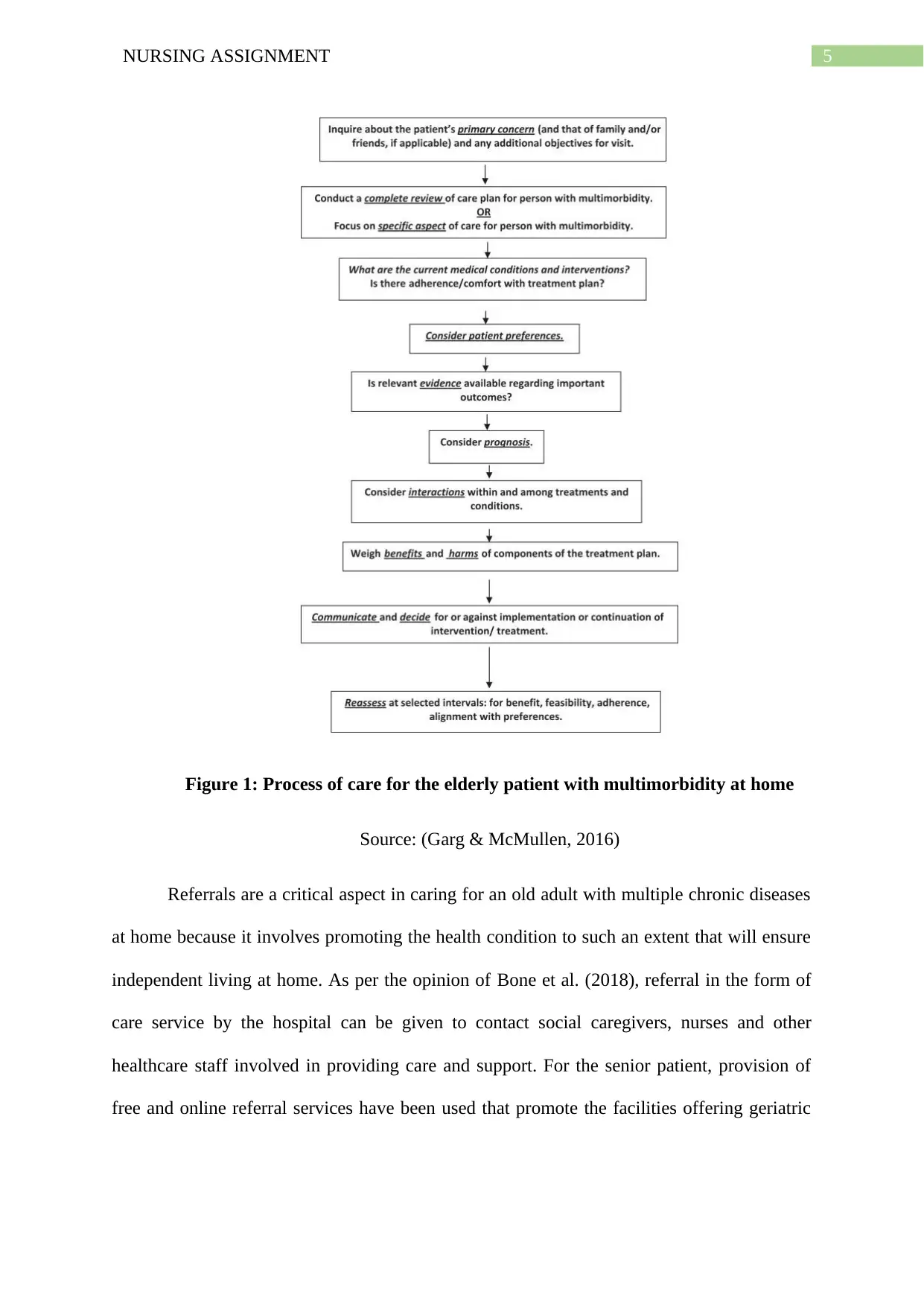
5NURSING ASSIGNMENT
Figure 1: Process of care for the elderly patient with multimorbidity at home
Source: (Garg & McMullen, 2016)
Referrals are a critical aspect in caring for an old adult with multiple chronic diseases
at home because it involves promoting the health condition to such an extent that will ensure
independent living at home. As per the opinion of Bone et al. (2018), referral in the form of
care service by the hospital can be given to contact social caregivers, nurses and other
healthcare staff involved in providing care and support. For the senior patient, provision of
free and online referral services have been used that promote the facilities offering geriatric
Figure 1: Process of care for the elderly patient with multimorbidity at home
Source: (Garg & McMullen, 2016)
Referrals are a critical aspect in caring for an old adult with multiple chronic diseases
at home because it involves promoting the health condition to such an extent that will ensure
independent living at home. As per the opinion of Bone et al. (2018), referral in the form of
care service by the hospital can be given to contact social caregivers, nurses and other
healthcare staff involved in providing care and support. For the senior patient, provision of
free and online referral services have been used that promote the facilities offering geriatric
⊘ This is a preview!⊘
Do you want full access?
Subscribe today to unlock all pages.

Trusted by 1+ million students worldwide
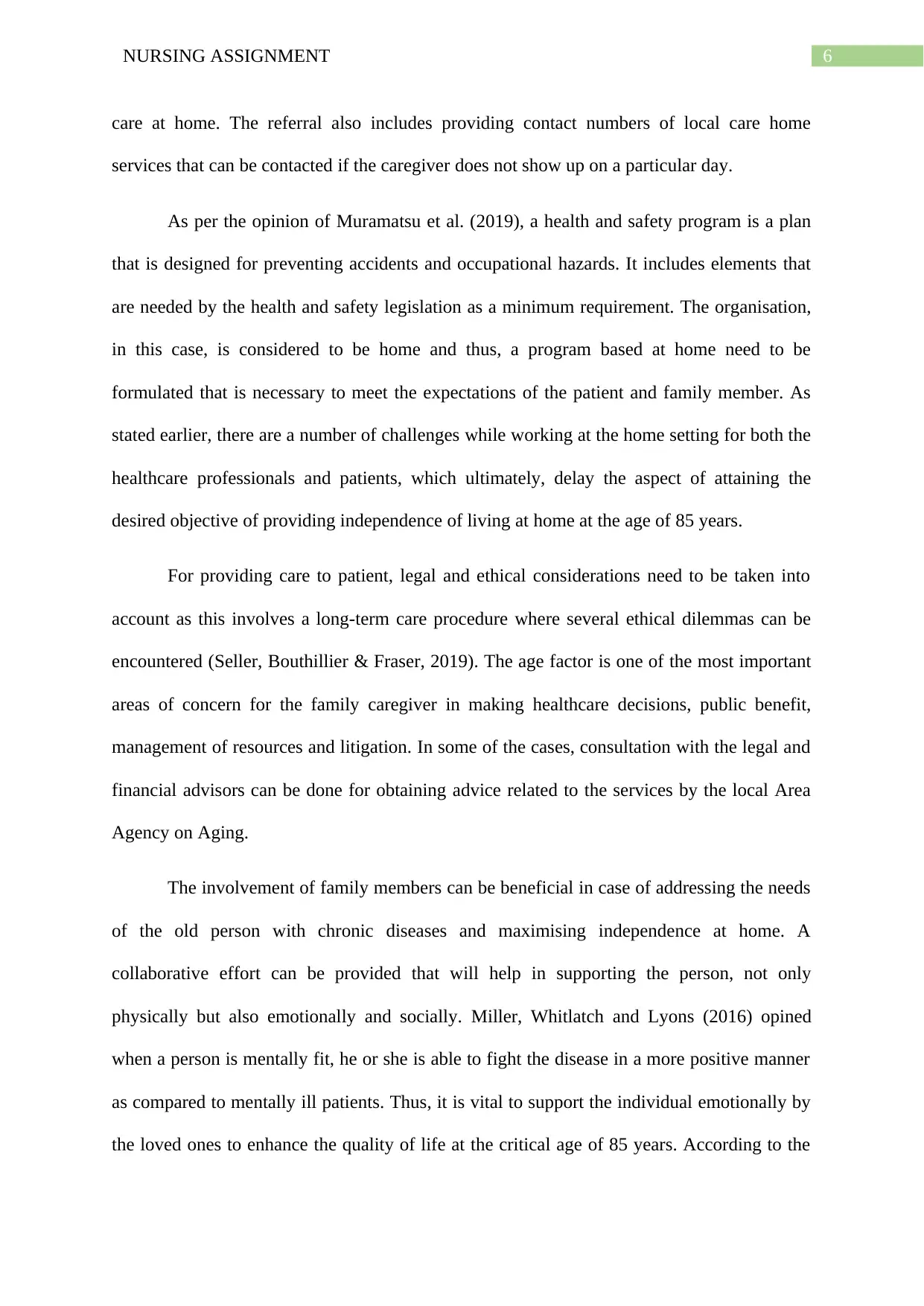
6NURSING ASSIGNMENT
care at home. The referral also includes providing contact numbers of local care home
services that can be contacted if the caregiver does not show up on a particular day.
As per the opinion of Muramatsu et al. (2019), a health and safety program is a plan
that is designed for preventing accidents and occupational hazards. It includes elements that
are needed by the health and safety legislation as a minimum requirement. The organisation,
in this case, is considered to be home and thus, a program based at home need to be
formulated that is necessary to meet the expectations of the patient and family member. As
stated earlier, there are a number of challenges while working at the home setting for both the
healthcare professionals and patients, which ultimately, delay the aspect of attaining the
desired objective of providing independence of living at home at the age of 85 years.
For providing care to patient, legal and ethical considerations need to be taken into
account as this involves a long-term care procedure where several ethical dilemmas can be
encountered (Seller, Bouthillier & Fraser, 2019). The age factor is one of the most important
areas of concern for the family caregiver in making healthcare decisions, public benefit,
management of resources and litigation. In some of the cases, consultation with the legal and
financial advisors can be done for obtaining advice related to the services by the local Area
Agency on Aging.
The involvement of family members can be beneficial in case of addressing the needs
of the old person with chronic diseases and maximising independence at home. A
collaborative effort can be provided that will help in supporting the person, not only
physically but also emotionally and socially. Miller, Whitlatch and Lyons (2016) opined
when a person is mentally fit, he or she is able to fight the disease in a more positive manner
as compared to mentally ill patients. Thus, it is vital to support the individual emotionally by
the loved ones to enhance the quality of life at the critical age of 85 years. According to the
care at home. The referral also includes providing contact numbers of local care home
services that can be contacted if the caregiver does not show up on a particular day.
As per the opinion of Muramatsu et al. (2019), a health and safety program is a plan
that is designed for preventing accidents and occupational hazards. It includes elements that
are needed by the health and safety legislation as a minimum requirement. The organisation,
in this case, is considered to be home and thus, a program based at home need to be
formulated that is necessary to meet the expectations of the patient and family member. As
stated earlier, there are a number of challenges while working at the home setting for both the
healthcare professionals and patients, which ultimately, delay the aspect of attaining the
desired objective of providing independence of living at home at the age of 85 years.
For providing care to patient, legal and ethical considerations need to be taken into
account as this involves a long-term care procedure where several ethical dilemmas can be
encountered (Seller, Bouthillier & Fraser, 2019). The age factor is one of the most important
areas of concern for the family caregiver in making healthcare decisions, public benefit,
management of resources and litigation. In some of the cases, consultation with the legal and
financial advisors can be done for obtaining advice related to the services by the local Area
Agency on Aging.
The involvement of family members can be beneficial in case of addressing the needs
of the old person with chronic diseases and maximising independence at home. A
collaborative effort can be provided that will help in supporting the person, not only
physically but also emotionally and socially. Miller, Whitlatch and Lyons (2016) opined
when a person is mentally fit, he or she is able to fight the disease in a more positive manner
as compared to mentally ill patients. Thus, it is vital to support the individual emotionally by
the loved ones to enhance the quality of life at the critical age of 85 years. According to the
Paraphrase This Document
Need a fresh take? Get an instant paraphrase of this document with our AI Paraphraser
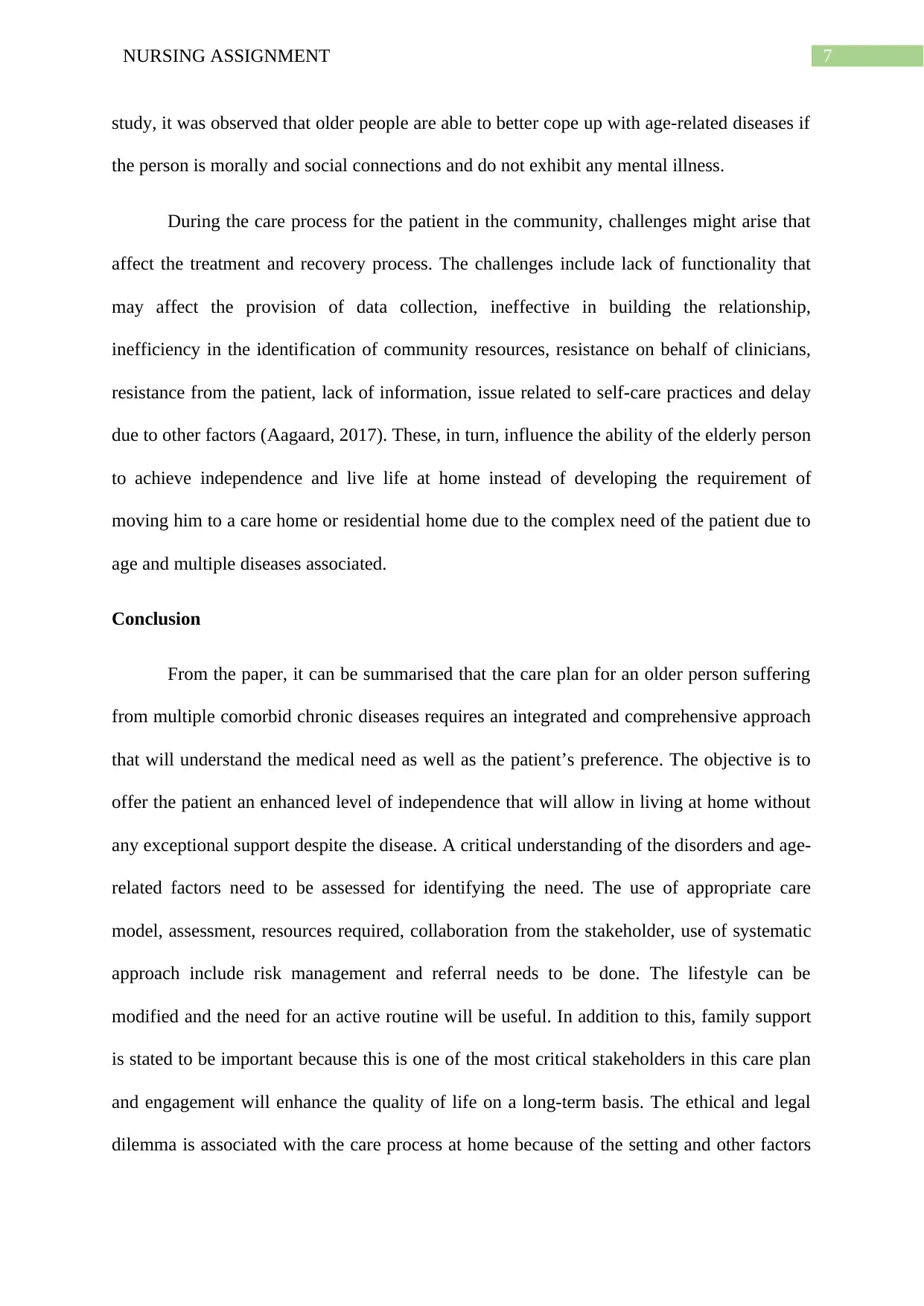
7NURSING ASSIGNMENT
study, it was observed that older people are able to better cope up with age-related diseases if
the person is morally and social connections and do not exhibit any mental illness.
During the care process for the patient in the community, challenges might arise that
affect the treatment and recovery process. The challenges include lack of functionality that
may affect the provision of data collection, ineffective in building the relationship,
inefficiency in the identification of community resources, resistance on behalf of clinicians,
resistance from the patient, lack of information, issue related to self-care practices and delay
due to other factors (Aagaard, 2017). These, in turn, influence the ability of the elderly person
to achieve independence and live life at home instead of developing the requirement of
moving him to a care home or residential home due to the complex need of the patient due to
age and multiple diseases associated.
Conclusion
From the paper, it can be summarised that the care plan for an older person suffering
from multiple comorbid chronic diseases requires an integrated and comprehensive approach
that will understand the medical need as well as the patient’s preference. The objective is to
offer the patient an enhanced level of independence that will allow in living at home without
any exceptional support despite the disease. A critical understanding of the disorders and age-
related factors need to be assessed for identifying the need. The use of appropriate care
model, assessment, resources required, collaboration from the stakeholder, use of systematic
approach include risk management and referral needs to be done. The lifestyle can be
modified and the need for an active routine will be useful. In addition to this, family support
is stated to be important because this is one of the most critical stakeholders in this care plan
and engagement will enhance the quality of life on a long-term basis. The ethical and legal
dilemma is associated with the care process at home because of the setting and other factors
study, it was observed that older people are able to better cope up with age-related diseases if
the person is morally and social connections and do not exhibit any mental illness.
During the care process for the patient in the community, challenges might arise that
affect the treatment and recovery process. The challenges include lack of functionality that
may affect the provision of data collection, ineffective in building the relationship,
inefficiency in the identification of community resources, resistance on behalf of clinicians,
resistance from the patient, lack of information, issue related to self-care practices and delay
due to other factors (Aagaard, 2017). These, in turn, influence the ability of the elderly person
to achieve independence and live life at home instead of developing the requirement of
moving him to a care home or residential home due to the complex need of the patient due to
age and multiple diseases associated.
Conclusion
From the paper, it can be summarised that the care plan for an older person suffering
from multiple comorbid chronic diseases requires an integrated and comprehensive approach
that will understand the medical need as well as the patient’s preference. The objective is to
offer the patient an enhanced level of independence that will allow in living at home without
any exceptional support despite the disease. A critical understanding of the disorders and age-
related factors need to be assessed for identifying the need. The use of appropriate care
model, assessment, resources required, collaboration from the stakeholder, use of systematic
approach include risk management and referral needs to be done. The lifestyle can be
modified and the need for an active routine will be useful. In addition to this, family support
is stated to be important because this is one of the most critical stakeholders in this care plan
and engagement will enhance the quality of life on a long-term basis. The ethical and legal
dilemma is associated with the care process at home because of the setting and other factors
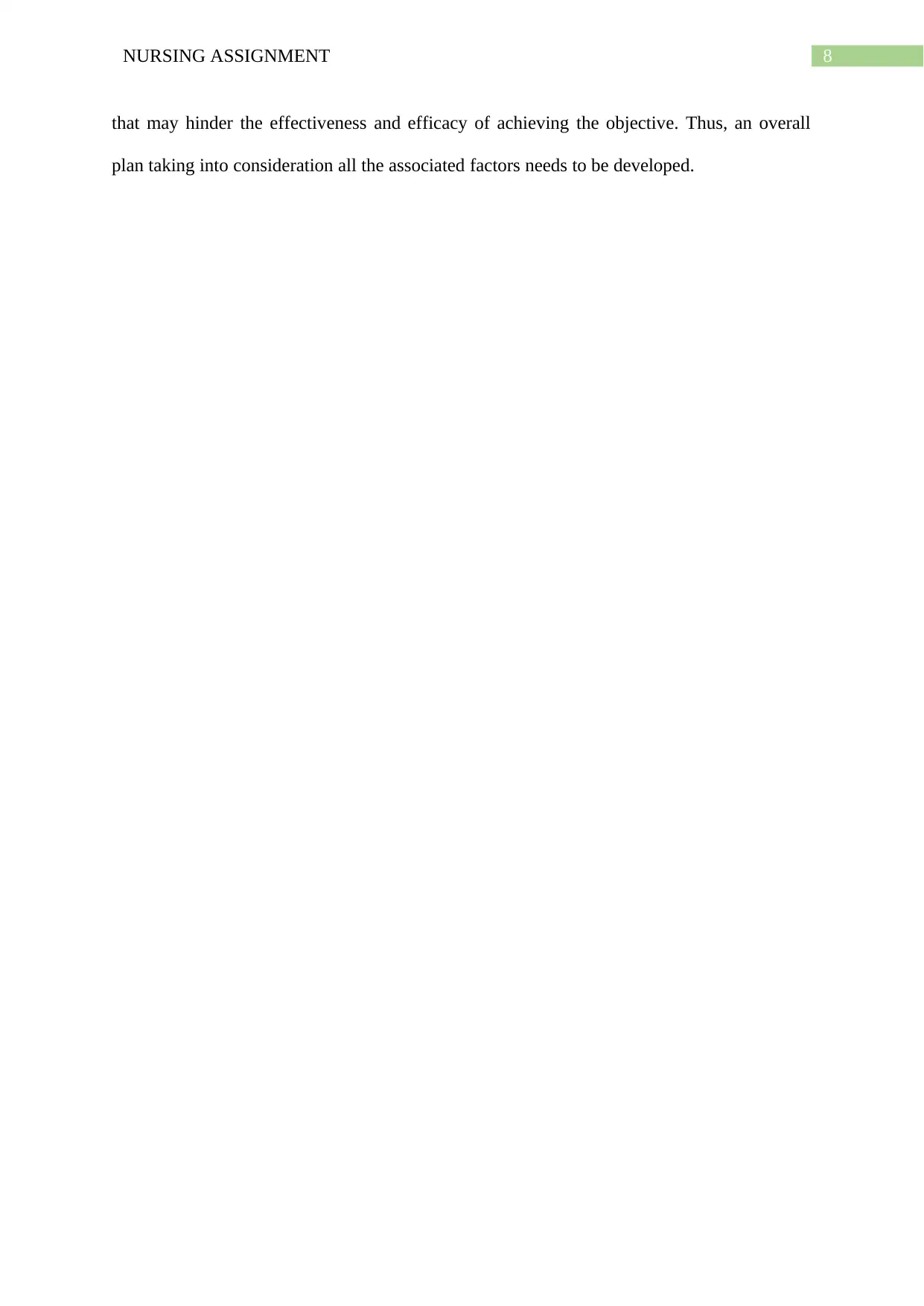
8NURSING ASSIGNMENT
that may hinder the effectiveness and efficacy of achieving the objective. Thus, an overall
plan taking into consideration all the associated factors needs to be developed.
that may hinder the effectiveness and efficacy of achieving the objective. Thus, an overall
plan taking into consideration all the associated factors needs to be developed.
⊘ This is a preview!⊘
Do you want full access?
Subscribe today to unlock all pages.

Trusted by 1+ million students worldwide
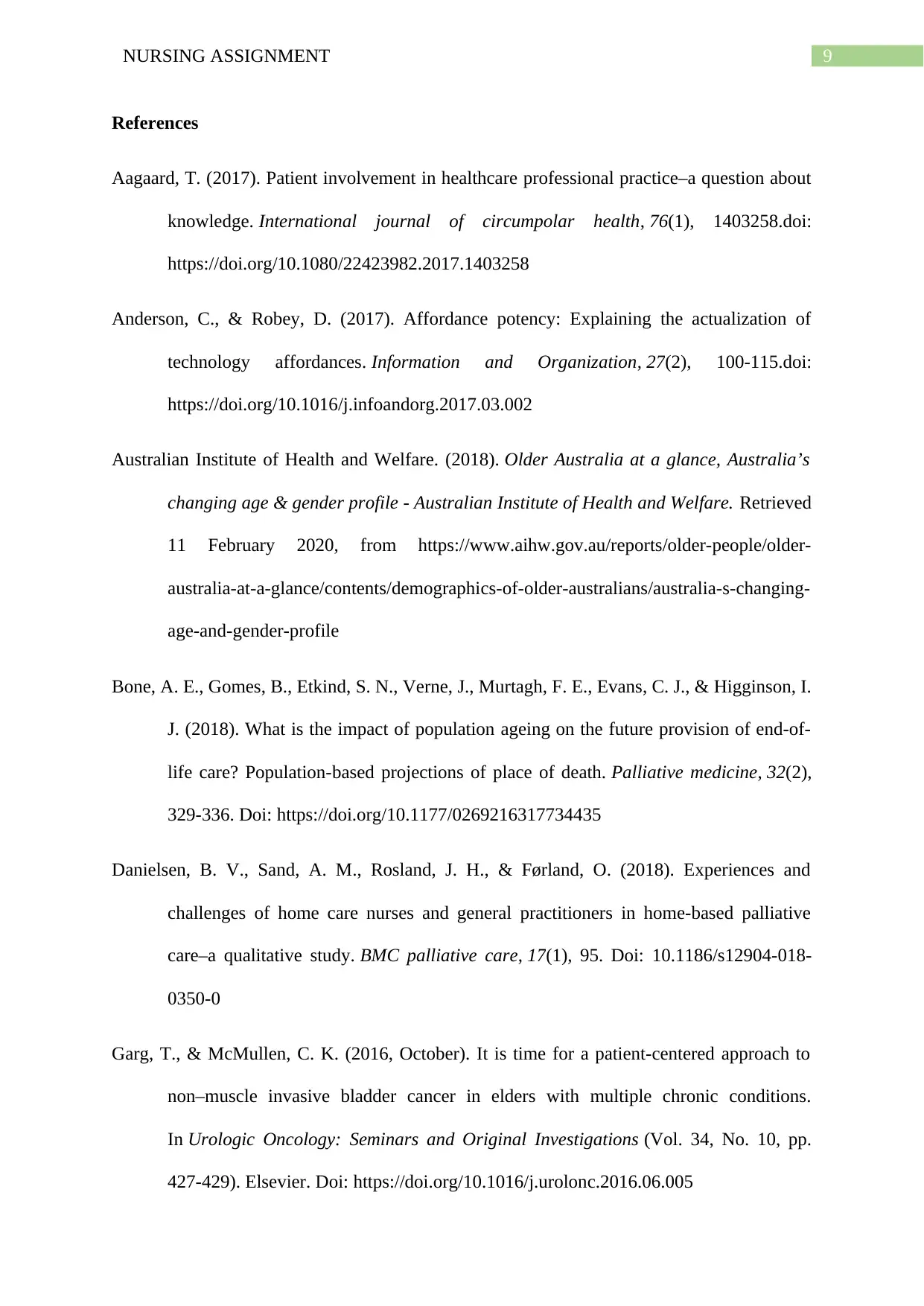
9NURSING ASSIGNMENT
References
Aagaard, T. (2017). Patient involvement in healthcare professional practice–a question about
knowledge. International journal of circumpolar health, 76(1), 1403258.doi:
https://doi.org/10.1080/22423982.2017.1403258
Anderson, C., & Robey, D. (2017). Affordance potency: Explaining the actualization of
technology affordances. Information and Organization, 27(2), 100-115.doi:
https://doi.org/10.1016/j.infoandorg.2017.03.002
Australian Institute of Health and Welfare. (2018). Older Australia at a glance, Australia’s
changing age & gender profile - Australian Institute of Health and Welfare. Retrieved
11 February 2020, from https://www.aihw.gov.au/reports/older-people/older-
australia-at-a-glance/contents/demographics-of-older-australians/australia-s-changing-
age-and-gender-profile
Bone, A. E., Gomes, B., Etkind, S. N., Verne, J., Murtagh, F. E., Evans, C. J., & Higginson, I.
J. (2018). What is the impact of population ageing on the future provision of end-of-
life care? Population-based projections of place of death. Palliative medicine, 32(2),
329-336. Doi: https://doi.org/10.1177/0269216317734435
Danielsen, B. V., Sand, A. M., Rosland, J. H., & Førland, O. (2018). Experiences and
challenges of home care nurses and general practitioners in home-based palliative
care–a qualitative study. BMC palliative care, 17(1), 95. Doi: 10.1186/s12904-018-
0350-0
Garg, T., & McMullen, C. K. (2016, October). It is time for a patient-centered approach to
non–muscle invasive bladder cancer in elders with multiple chronic conditions.
In Urologic Oncology: Seminars and Original Investigations (Vol. 34, No. 10, pp.
427-429). Elsevier. Doi: https://doi.org/10.1016/j.urolonc.2016.06.005
References
Aagaard, T. (2017). Patient involvement in healthcare professional practice–a question about
knowledge. International journal of circumpolar health, 76(1), 1403258.doi:
https://doi.org/10.1080/22423982.2017.1403258
Anderson, C., & Robey, D. (2017). Affordance potency: Explaining the actualization of
technology affordances. Information and Organization, 27(2), 100-115.doi:
https://doi.org/10.1016/j.infoandorg.2017.03.002
Australian Institute of Health and Welfare. (2018). Older Australia at a glance, Australia’s
changing age & gender profile - Australian Institute of Health and Welfare. Retrieved
11 February 2020, from https://www.aihw.gov.au/reports/older-people/older-
australia-at-a-glance/contents/demographics-of-older-australians/australia-s-changing-
age-and-gender-profile
Bone, A. E., Gomes, B., Etkind, S. N., Verne, J., Murtagh, F. E., Evans, C. J., & Higginson, I.
J. (2018). What is the impact of population ageing on the future provision of end-of-
life care? Population-based projections of place of death. Palliative medicine, 32(2),
329-336. Doi: https://doi.org/10.1177/0269216317734435
Danielsen, B. V., Sand, A. M., Rosland, J. H., & Førland, O. (2018). Experiences and
challenges of home care nurses and general practitioners in home-based palliative
care–a qualitative study. BMC palliative care, 17(1), 95. Doi: 10.1186/s12904-018-
0350-0
Garg, T., & McMullen, C. K. (2016, October). It is time for a patient-centered approach to
non–muscle invasive bladder cancer in elders with multiple chronic conditions.
In Urologic Oncology: Seminars and Original Investigations (Vol. 34, No. 10, pp.
427-429). Elsevier. Doi: https://doi.org/10.1016/j.urolonc.2016.06.005
Paraphrase This Document
Need a fresh take? Get an instant paraphrase of this document with our AI Paraphraser
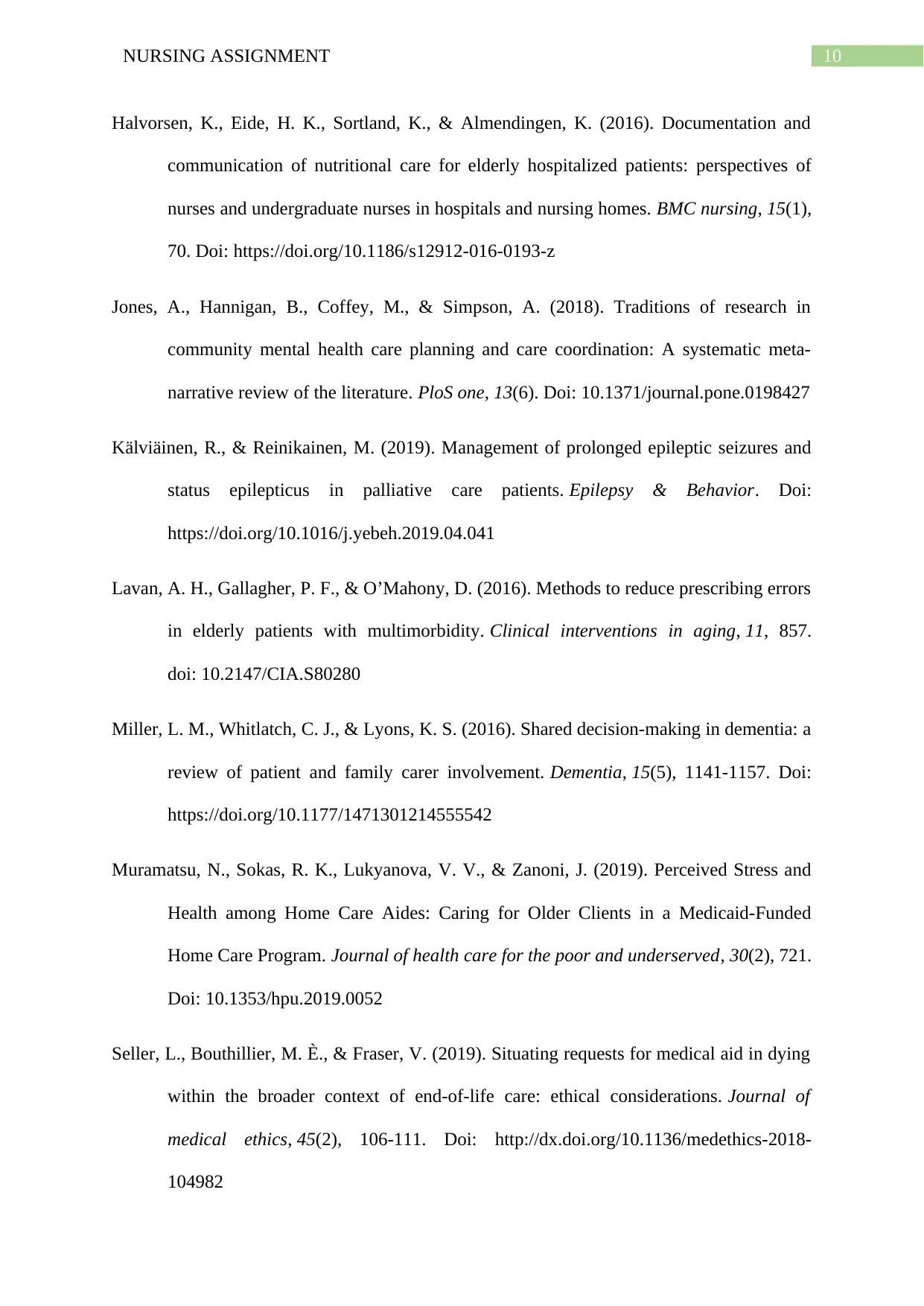
10NURSING ASSIGNMENT
Halvorsen, K., Eide, H. K., Sortland, K., & Almendingen, K. (2016). Documentation and
communication of nutritional care for elderly hospitalized patients: perspectives of
nurses and undergraduate nurses in hospitals and nursing homes. BMC nursing, 15(1),
70. Doi: https://doi.org/10.1186/s12912-016-0193-z
Jones, A., Hannigan, B., Coffey, M., & Simpson, A. (2018). Traditions of research in
community mental health care planning and care coordination: A systematic meta-
narrative review of the literature. PloS one, 13(6). Doi: 10.1371/journal.pone.0198427
Kälviäinen, R., & Reinikainen, M. (2019). Management of prolonged epileptic seizures and
status epilepticus in palliative care patients. Epilepsy & Behavior. Doi:
https://doi.org/10.1016/j.yebeh.2019.04.041
Lavan, A. H., Gallagher, P. F., & O’Mahony, D. (2016). Methods to reduce prescribing errors
in elderly patients with multimorbidity. Clinical interventions in aging, 11, 857.
doi: 10.2147/CIA.S80280
Miller, L. M., Whitlatch, C. J., & Lyons, K. S. (2016). Shared decision-making in dementia: a
review of patient and family carer involvement. Dementia, 15(5), 1141-1157. Doi:
https://doi.org/10.1177/1471301214555542
Muramatsu, N., Sokas, R. K., Lukyanova, V. V., & Zanoni, J. (2019). Perceived Stress and
Health among Home Care Aides: Caring for Older Clients in a Medicaid-Funded
Home Care Program. Journal of health care for the poor and underserved, 30(2), 721.
Doi: 10.1353/hpu.2019.0052
Seller, L., Bouthillier, M. È., & Fraser, V. (2019). Situating requests for medical aid in dying
within the broader context of end-of-life care: ethical considerations. Journal of
medical ethics, 45(2), 106-111. Doi: http://dx.doi.org/10.1136/medethics-2018-
104982
Halvorsen, K., Eide, H. K., Sortland, K., & Almendingen, K. (2016). Documentation and
communication of nutritional care for elderly hospitalized patients: perspectives of
nurses and undergraduate nurses in hospitals and nursing homes. BMC nursing, 15(1),
70. Doi: https://doi.org/10.1186/s12912-016-0193-z
Jones, A., Hannigan, B., Coffey, M., & Simpson, A. (2018). Traditions of research in
community mental health care planning and care coordination: A systematic meta-
narrative review of the literature. PloS one, 13(6). Doi: 10.1371/journal.pone.0198427
Kälviäinen, R., & Reinikainen, M. (2019). Management of prolonged epileptic seizures and
status epilepticus in palliative care patients. Epilepsy & Behavior. Doi:
https://doi.org/10.1016/j.yebeh.2019.04.041
Lavan, A. H., Gallagher, P. F., & O’Mahony, D. (2016). Methods to reduce prescribing errors
in elderly patients with multimorbidity. Clinical interventions in aging, 11, 857.
doi: 10.2147/CIA.S80280
Miller, L. M., Whitlatch, C. J., & Lyons, K. S. (2016). Shared decision-making in dementia: a
review of patient and family carer involvement. Dementia, 15(5), 1141-1157. Doi:
https://doi.org/10.1177/1471301214555542
Muramatsu, N., Sokas, R. K., Lukyanova, V. V., & Zanoni, J. (2019). Perceived Stress and
Health among Home Care Aides: Caring for Older Clients in a Medicaid-Funded
Home Care Program. Journal of health care for the poor and underserved, 30(2), 721.
Doi: 10.1353/hpu.2019.0052
Seller, L., Bouthillier, M. È., & Fraser, V. (2019). Situating requests for medical aid in dying
within the broader context of end-of-life care: ethical considerations. Journal of
medical ethics, 45(2), 106-111. Doi: http://dx.doi.org/10.1136/medethics-2018-
104982
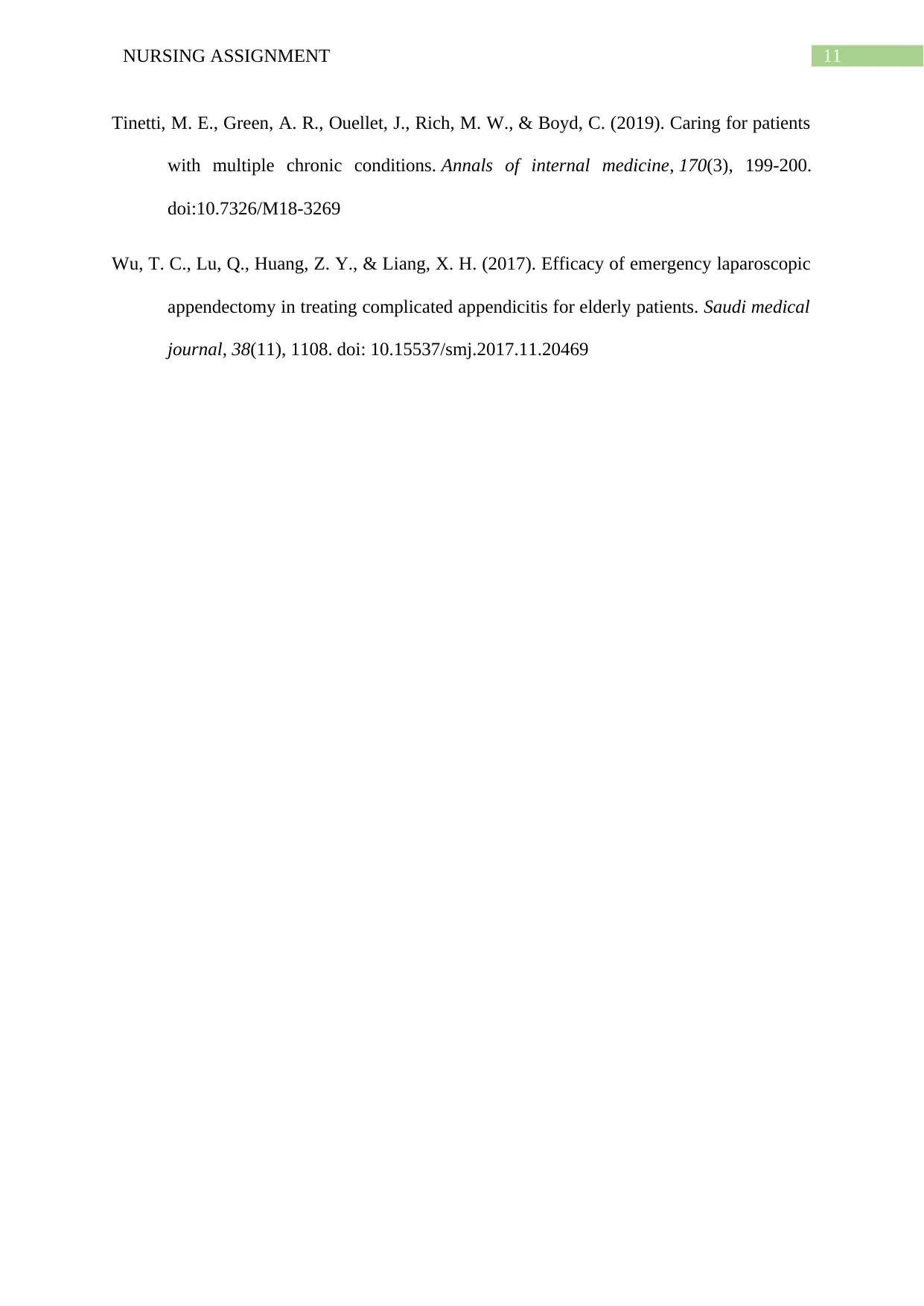
11NURSING ASSIGNMENT
Tinetti, M. E., Green, A. R., Ouellet, J., Rich, M. W., & Boyd, C. (2019). Caring for patients
with multiple chronic conditions. Annals of internal medicine, 170(3), 199-200.
doi:10.7326/M18-3269
Wu, T. C., Lu, Q., Huang, Z. Y., & Liang, X. H. (2017). Efficacy of emergency laparoscopic
appendectomy in treating complicated appendicitis for elderly patients. Saudi medical
journal, 38(11), 1108. doi: 10.15537/smj.2017.11.20469
Tinetti, M. E., Green, A. R., Ouellet, J., Rich, M. W., & Boyd, C. (2019). Caring for patients
with multiple chronic conditions. Annals of internal medicine, 170(3), 199-200.
doi:10.7326/M18-3269
Wu, T. C., Lu, Q., Huang, Z. Y., & Liang, X. H. (2017). Efficacy of emergency laparoscopic
appendectomy in treating complicated appendicitis for elderly patients. Saudi medical
journal, 38(11), 1108. doi: 10.15537/smj.2017.11.20469
⊘ This is a preview!⊘
Do you want full access?
Subscribe today to unlock all pages.

Trusted by 1+ million students worldwide
1 out of 12
Related Documents
Your All-in-One AI-Powered Toolkit for Academic Success.
+13062052269
info@desklib.com
Available 24*7 on WhatsApp / Email
![[object Object]](/_next/static/media/star-bottom.7253800d.svg)
Unlock your academic potential
Copyright © 2020–2025 A2Z Services. All Rights Reserved. Developed and managed by ZUCOL.





